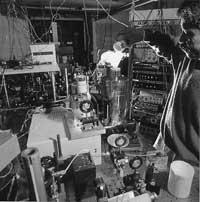The most accurate clock in the world
Last year the Paris observatory has broken all the precision records of the watches in the Basic Laboratory of Time and Frequency (LPTF). Using the atomic clock they have prepared have reached an accuracy of 10-15 seconds, the femtosecond. This very short time interval can be expressed differently: 0,000 000 000 000 001 seconds. To become aware of such a short time is not easy, of course, since the nerve quinada that expands at the speed of light needs so much to move within the neuron.
In the LPTF laboratory in Paris, Michel Granveaud and his team are mainly engaged in the preparation of cesium atomic clocks, and the result of their work has been to get the most accurate clock in the world, although others are also doing it in the world. In the United States, people working at the NIST (National Institute of Standards and Technology), Japanese, German, etc. have managed to approach until 10-14 s. It is also another laboratory in France dedicated to the atomic clock, that of Orsay. This watch is basically the same as the rest, but it replaces cesium atoms with calcium ions. In fact, charged particles can be easier to handle by electromagnetic fields. In addition, the transition frequency chosen in the calcium ion is in the field visible in red.
What is the second and why
When he wondered what the second was until a few years ago, the answer was that of sixty minutes or 3,600 hours. However, in 1967 the definition of the second changed. According to the General Assembly of Measures and Weights, the definition of the second is the time interval of 9 192 631 770 transitional radiation periods between the two hyperfine levels of the basic energy state of the cesium atom 133. In other words, the new pattern of time measurement is the period of the wave emitted by passing an electron within the cesium atom from one layer of energy to another more internal.

International atomic time is calculated at the Paris Office of Measures and Weights from the average of 250 atomic clocks spread around the world. It must be remembered that the atomic clock can have a maximum delay or advance of 0.0001 seconds after a thousand years.
More than one will ask what is the purpose of such a precise definition and clock of the second, and the answer lies in the needs of new technologies and basic research. Time and space are related concepts. For example, using the satellite and atomic clock, you can locate a point of the earth very precisely.
It is calculated based on the time it takes for light to run. Therefore, the higher the precision of the clock, the more accurate the ground point will be. The 24 satellites at 20,000 kilometers of altitude have a precision of one meter to locate ground points using the GPS (Global Posityonning System) and atomic clocks in military applications and 10 meters in civil applications. If atomic clocks were like those of the Paris observatory, accuracy would be one-tenth of the millimeter. This GPS system is used to measure earthquakes, detect Paris-Dakar rally cars or measure continental drift.
Looking for gravitational waves
Many of the great scientific discoveries have occurred thanks to the advance in time measurement: In 1676, for example, it was discovered that the speed of light had a finite value and that in 1937 the rotation of the Earth was irregular. In 1983 the metro was otherwise defined as the distance that light went through in the vacuum 1/299 792 458 seconds.
Today, however, researchers are looking for more accurate clocks to detect the famous “gravitational waves” announced by Einstein in 1916. These waves would emit accelerated masses, just as the charged moving particle emits electromagnetic waves. If gravitational waves were found, in addition to confirming the Theory of Relativity, the laws of gravitation and electromagnetism would be united.
Pulses or pulses of pulsars seem to confirm the existence of gravitational waves. Pulsars are neutron stars that spin more than a hundred revolutions per second around their axis. Gravitational waves cause ups and downs in the signals emitted by pulsars, but these infinitesimal ones cannot be detected if they are not extreme precision clocks.
How does the atomic clock work?In atomic clocks it can be said that the pendulum is replaced by a wave generator. The wave has peaks and depressions and the period is the time from one point to the next. The period can therefore represent the time unit, but a wave with a regular and stable period is needed. For this purpose the cesium atom is normally taken. When a certain wavelength (corresponding to a frequency of 9,192 631 770 GHz) is excited, the energy level changes. The higher the proportion of excited atoms, the closer we approach that wavelength (and therefore the ideal period or the miniunit of time). Therefore, the wave generator is regulated so that as many excited cesium atoms as possible are obtained. This makes the watch accurate to 10 to 15”. In zone 1 of the watch there is cesium, usually a solid metal. First it becomes gas. At first the atoms are placed at the same basic energy level and then cooled with laser beams up to microcelvin (very close to absolute zero). The cooling of atoms reduces their speed and decreases from the previous 100 m/s to about cm/s. Subsequently, in Zone 2, cesium atoms are sent to microwaves emitted by a quartz generator and some are excited. Atoms fall and pass through a detector in Zone 3. Given the number of excited atoms, the generator period is regulated so that the emitted waves excite as many atoms as possible. The wave period is then measured and multiplied by 9 192 631 770 giving the second of the clock. |





